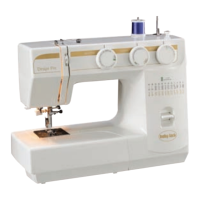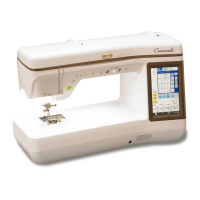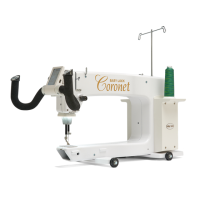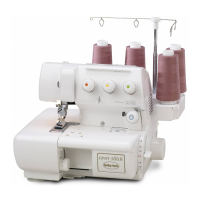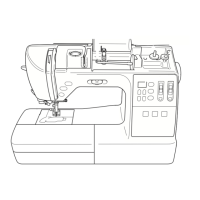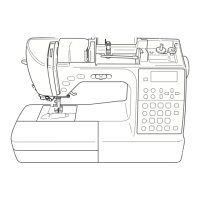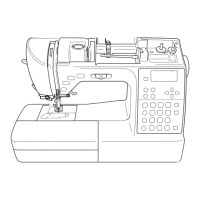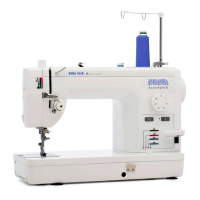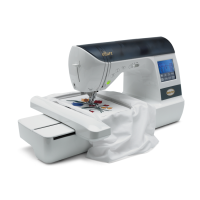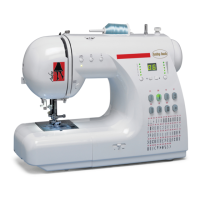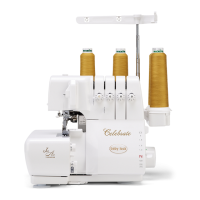
Do you have a question about the Baby Lock Celebrate BLS1 and is the answer not in the manual?
| Type | Serger |
|---|---|
| Stitch Options/Built-in Stitches | 4 |
| Maximum Stitch Width | 7 mm |
| Maximum Stitch Length | 4 mm |
| Differential Feed | Yes |
| Weight | 16 lbs |
| Needle Threader | Yes |
| Maximum Sewing Speed | 1, 500 stitches per minute |
| Built-in Memory | No |
| Number of Threads | 4/3/2 |
Instructions to reduce the risk of electric shock.
Precautions to prevent burns, fire, electric shock, or injury to persons.
Explains the basic function and process of a serger machine.
Identifies and labels the various parts of the Baby Lock Celebrate serger.
Lists and describes the included accessories for the serger.
Information on needle types, size, and replacement.
Guidance on thread types, quality, and recommendations for optimal performance.
Lists optional snap-on specialty feet available from Baby Lock retailers.
Step-by-step instructions for unpacking and setting up the serger.
How to lock and unlock the cutting blade for specific sewing tasks.
How to adjust presser foot pressure for different fabric types.
Instructions for releasing and replacing the snap-on presser foot.
How to adjust stitch length for standard sewing and rolled edges.
How to adjust stitch width using the dial and needle placement.
Explains how to use differential feed for gathering or stretching fabric.
Instructions for engaging and disengaging the subsidiary looper for 2-thread sewing.
How to prepare threads and spools for serger threading.
Overview of the Jet-Air Threading System and general threading process.
Step-by-step guide to threading the lower looper using the system.
Step-by-step guide to threading the upper looper using the system.
Instructions for threading the right needle.
Instructions for threading the left needle.
Detailed steps on using the automatic needle threader.
Guidance on adjusting thread tensions for optimal stitch formation.
How to start serging, feed fabric, and create thread chains.
How to clear threads caught on the stitch width fingers.
Procedure for re-threading loopers when a thread breaks.
Procedure for re-threading needles when a thread breaks.
Using the 4-thread overlock for finishing edges and seams.
Stitching and finishing seams in one operation with 4 threads.
Details the structure and function of the 4-thread overlock stitch.
Using 3-thread serging for edge finishing and seaming knits.
How to achieve a narrow rolled edge for sheer and lightweight fabrics.
Specific steps for creating a 3-thread rolled edge.
Using the rolled hem setting for French seams on sheer fabrics.
How to create a decorative 'lettuce' edge on lightweight fabrics.
Using rolled edge thread chain for making belt and button loops.
Steps to revert from rolled edging to standard serging settings.
Explains the economical and less bulky 2-thread overedge function.
How to convert the machine from 3-thread to 2-thread serging.
Creating flatlock seams for non-raveling, decorative joins on specific fabrics.
Using flatlock stitch for decorative effects on fabric folds.
How to create sturdy, nearly invisible blind hems using 2-thread overlock.
Achieving a rolled edge using 2 threads for softer fabric finishes.
Methods for securing the beginning and end of serger seams to prevent unraveling.
Technique for serging around outside corners smoothly.
Technique for serging around inside corners neatly.
Guidance on serging smooth curves, inside or outside.
How to use the presser foot slot to insert stabilizing tape or ribbon.
Using seam guide marks on the cover for accurate seam allowances.
How specialty threads, cords, and ribbons can create beautiful stitches.
How to thread lightweight specialty threads through the machine.
Steps for changing threads, including tying knots.
Techniques for threading bulky medium weight threads.
Using a thread cradle to thread specialty threads in loopers.
Using the tool to thread specialty threads through loopers.
Techniques for threading heavy weight threads by bypassing the port.
Chart recommending specialty threads for various stitch types and applications.
Continues the chart recommending specialty threads for various applications.
Step-by-step guide on how to remove and replace serger needles.
Instructions for replacing the upper moving cutting blade.
Recommends regular cleaning to maintain optimal machine performance.
Information on the LED lighting system and replacement.
Checks to perform when the machine fails to start or has thread breaks.
Further troubleshooting for skipped stitches, fabric feeding, and unbalanced stitches.
Essential safety and operational guidelines for using the serger.
Provides key technical specifications of the Baby Lock Celebrate serger.
Recommended tension numbers and settings for various stitch types.
